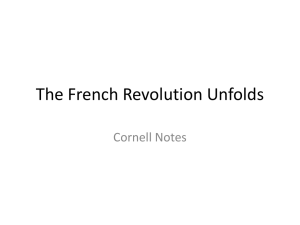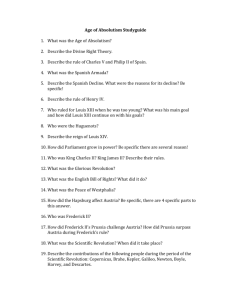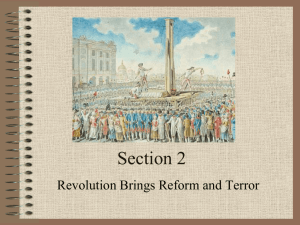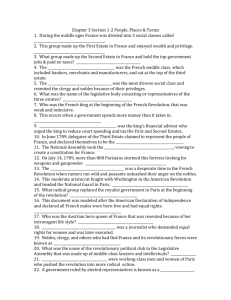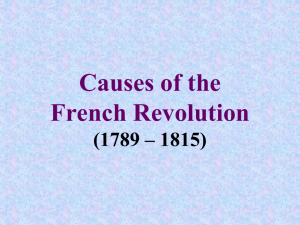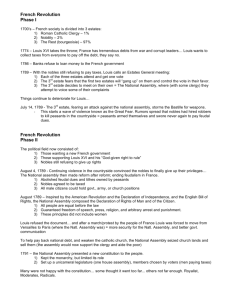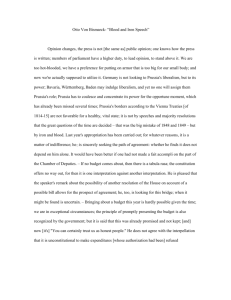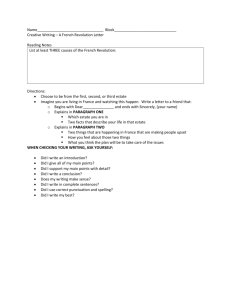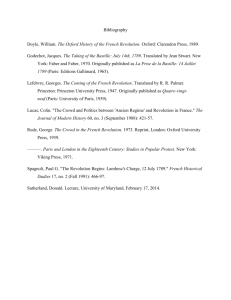File
advertisement
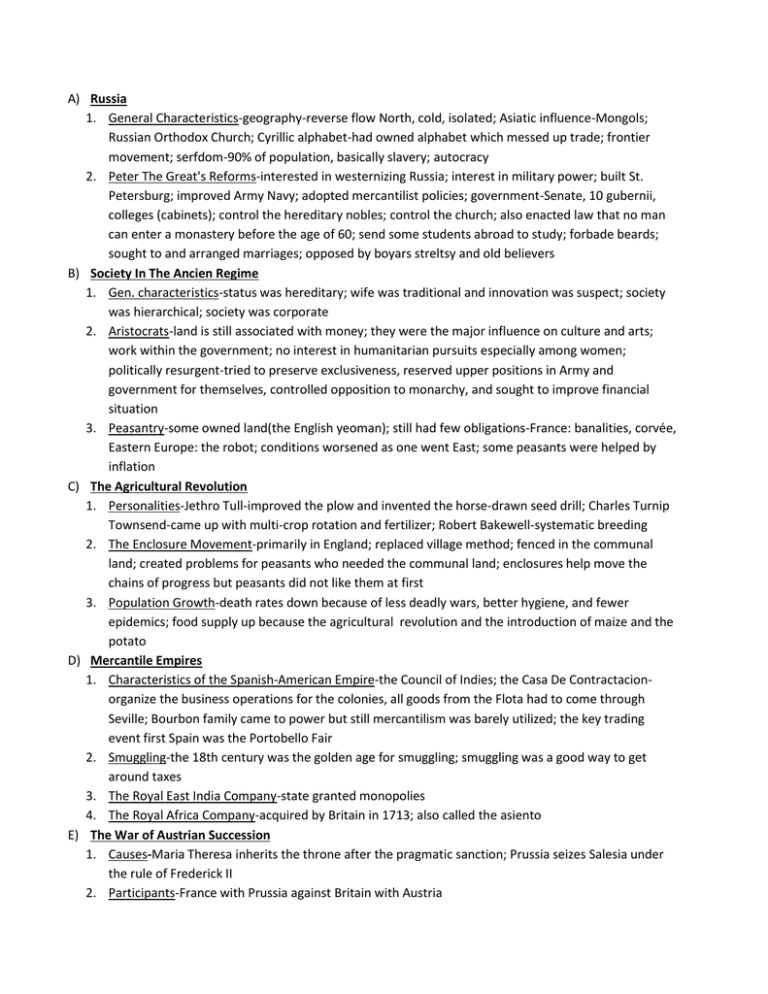
A) Russia 1. General Characteristics-geography-reverse flow North, cold, isolated; Asiatic influence-Mongols; Russian Orthodox Church; Cyrillic alphabet-had owned alphabet which messed up trade; frontier movement; serfdom-90% of population, basically slavery; autocracy 2. Peter The Great's Reforms-interested in westernizing Russia; interest in military power; built St. Petersburg; improved Army Navy; adopted mercantilist policies; government-Senate, 10 gubernii, colleges (cabinets); control the hereditary nobles; control the church; also enacted law that no man can enter a monastery before the age of 60; send some students abroad to study; forbade beards; sought to and arranged marriages; opposed by boyars streltsy and old believers B) Society In The Ancien Regime 1. Gen. characteristics-status was hereditary; wife was traditional and innovation was suspect; society was hierarchical; society was corporate 2. Aristocrats-land is still associated with money; they were the major influence on culture and arts; work within the government; no interest in humanitarian pursuits especially among women; politically resurgent-tried to preserve exclusiveness, reserved upper positions in Army and government for themselves, controlled opposition to monarchy, and sought to improve financial situation 3. Peasantry-some owned land(the English yeoman); still had few obligations-France: banalities, corvée, Eastern Europe: the robot; conditions worsened as one went East; some peasants were helped by inflation C) The Agricultural Revolution 1. Personalities-Jethro Tull-improved the plow and invented the horse-drawn seed drill; Charles Turnip Townsend-came up with multi-crop rotation and fertilizer; Robert Bakewell-systematic breeding 2. The Enclosure Movement-primarily in England; replaced village method; fenced in the communal land; created problems for peasants who needed the communal land; enclosures help move the chains of progress but peasants did not like them at first 3. Population Growth-death rates down because of less deadly wars, better hygiene, and fewer epidemics; food supply up because the agricultural revolution and the introduction of maize and the potato D) Mercantile Empires 1. Characteristics of the Spanish-American Empire-the Council of Indies; the Casa De Contractacionorganize the business operations for the colonies, all goods from the Flota had to come through Seville; Bourbon family came to power but still mercantilism was barely utilized; the key trading event first Spain was the Portobello Fair 2. Smuggling-the 18th century was the golden age for smuggling; smuggling was a good way to get around taxes 3. The Royal East India Company-state granted monopolies 4. The Royal Africa Company-acquired by Britain in 1713; also called the asiento E) The War of Austrian Succession 1. Causes-Maria Theresa inherits the throne after the pragmatic sanction; Prussia seizes Salesia under the rule of Frederick II 2. Participants-France with Prussia against Britain with Austria 3. Results-The Treaty of Aix-la Chapelle which reestablished everything that was before the war except for the Prussian annexation of Salesia F) The Diplomatic Revolution Of 1756 And The Seven Years War 1. Causes-the diplomatic revolution-Britain Allied with Prussia and Austria with France; the emergence of German dualism-Prussia and Austria are rivals to control central Europe 2. Theaters of Action-a true world war; Prussia with Britain support against France Austria and Russia; the goal was the partition of Prussia; pressure survived because-Frederick the great was the best, British money, the Russians quit and went home, and the French lost interest; while in AmericaBritain one because of William Pitt the Elder's leadership and a superior British Navy, its key battles were: Fort Duquesne (French victory), Québec (British victory); while in India-French trading interest (led by Joseph François Dupleix and sepoy army) fought the British trading interest(led by Robert Clive and his sepoy army), major battles were: Battle Of Plassy which gained most of Indiana for the British East India Company 3. Results-The Treaty of Hubertusburg which recognized Prussia's claims to Salesia; The Treaty of Paris of 1763 which gave up all French possessions in North America to Britain, made French see all claims to land west of the Mississippi to Spain, but France still retained fishing rights and sugar islands of the West Indies; 1763 was a major turning point in European history; Prussia was to remain existence and become stronger; German dualism was to continue; no gray commercial calamity for France; British Sea power was supreme; no commercial channels for British; European balance of power preserved; America North of Mexico became a English speaking world; bridging the acquired territory in India G) American Revolution and British Politics 1. The John Wilkes Case-accused of libel; appeal to the general public for support; confronted Parliament and King making the King look bad to Americans 2. Major John Cartwright- criticized the unequal voting districts of Parliament; sought annual elections 3. Influences of America on Britain-the influence of government based on a prescriptive Constitution; the creation of representative bodies; consent of the government; popular sovereignty H) The Enlightenment 1. Characteristics-reforms; a culture based on the printing of knowledge; liberty; progress through reason; natural laws 2. Major Players-John Lock-Essay concerning Human Understanding, everybody is born with a tabula rasa; Denis Diderot-editor of the Encyclopedie, wanted a record of scientific and secular discoveries, believed men and women should be in separate spheres; Voltaire(François Marie Arouet)-Candide ou l’Optimisme (a satire), believed in freedom of thought, religious toleration, Ecuasez l’Infame; Jean Jacques Rousseau-Emile, man is born good but made evil by society, the general will: the course of action is best for society; Marquis Cesare Beccaria-reformed the criminal system; François Quesnay and Pierre du Pont de Nemoure-physiocrats; Adam Smith-Scottish moral philosopher and physical economist, wrote the Wealth of Nations, believed in free trade, father of laissez faire; Baron de Montesquieu-somewhat sympathetic to women, said that women were naturally inferior to men, still believed in the traditional view of marriage and family; Mary Wollstencraft-A Vindication of the Rights of Women, argued that women are equal to men; David Hume-Treatise of Human Nature, attacked churches and religion; Immanuel Kant-most important figure in German enlightenment, Critique of Pure Reason (criticized reason itself), inspired romantic artists; John Calas case-was brutally tortured after being accused of killing his son after his sudden said he would convert from to Roman Catholicism I) Enlightened Despotism 1. Differences From 17th Century Monarchs-desire to reform; decisions based on reason; little focus on divine right; religious toleration; curtailed independence of nobles and church; wanted more efficient government; built-up infrastructure 2. Frederick II (The Great)-double the population of Prussia; Prussia became a great European power; Seven Years War-Prussia first everyone and Prussia survived; 80 knowledge and technological reform; never try to change existing social system; was religiously tolerant; saw himself as the “first servant of the state” 3. Joseph II-co-region with his mother Maria Theresa; wanted to centralize governments; once you control the Catholic Church (Josephinism); was religiously tolerant; abolished serfdom; the new law code; every single person hated him 4. Catherine II (The Great)-German princess who came to be ruler of Russia and was well-liked by philosophes; she imported Western architects sculptors and musicians; correspond with philosophes; published Diderot's Encyclopedia; allowed religious toleration; tried to improve education; did nothing to improve serfdom (Pugachev's Rebellion); expanding territory by the annexation of Crimea and in The Partition of Poland J) French Revolution 1. Causes-long term: the monarchy was weak; there were many social conflicts; there was a poor harvest and they were depression; the aristocrats were resurgent; the Enlightenment; short-term: financial crisis from the seven years war; Louis XV instituted the Maupeou Parlements; Louis XVI disbanded the Maupeou Parlements; Louis XVI financial advisors-Jean Turgot told Louis the tax nobles, Jaques Necker told Louis to tax nobles, Charles Andre de Calline tried Institute a universal land tax which was frowned upon by nobles, Lomenie de Brienne tried to push system to Parlement of Paris and then failed; The Assembly of Notables-called to grant the King permission to tax didn't work out; Louis promised to call the estates general 2. The Three Estates-the first estate: clergy; owned 10% of land; paid only voluntary gifts; 300 representatives; the second estate: nobility; only 25 and 30% of land; were tax-exempt; 300 representatives; the third estate: peasant owned 25 to 40% of lands and were 75 to 85% of population; bourgeoisie owned 20 to 25% of land and was made up of 2.3 million people; 600 representatives; major problem was how to vote 3. June 17, 1789, July 14, 1789, August 4, 1789-June 17, 1789: the third estate declared itself the national assembly and decided to draw up a Constitution set; July 14, 1789; King attempted to take defensive measures by increasing number of troops acts arsenals and Paris and along road to Versailles the people of Paris though stormed the Bastille; August 4, 1789: in Africa and the great fear nobles in the assembly agreed to abolish all feudal privileges ending the ancien regime 4. The National Constituent Assembly-what the national assembly called itself after they wrote The Declaration of the Rights of Man and Citizen 5. The Declaration of the Rights of Man-was very much like the Constitution; charter of basic liberties 6. Civil Constitution of the Clergy-was a big mistake for Louis; said clergy would be elected and employed by the state; religious toleration would be encouraged; the clergy who refused to sign were called the refractory clergy 7. The Le Chapelier Law-outlawing unions and guilds; assignats (bonds) were issued to pay debts 8. The Constitution of 1791-created a new government; a unicameral house; elected assembly called legislative assembly; 745 representatives chosen by indirect elections; sacked two years; Constitution except by Louis 9. Jacobins-a bourgeoisie group favoring a Republic; political party 10. Girondists-members of the Jacobin club; believed that revolution must be spread; the more moderate high after the Jacobins divided; wanted a Republic 11. The Mountain-the more radical half of the Jacobins after the divided 12. Sans-Culottes-French workers; seized control of city governments; imprisoned the King and Queen; revoked the Constitution; form a constitutional convention; believed in full equality; price controls on bread; began to cooperate with the Mountain; Jean Paul Marat-serve as bridge between mountain and sans-culottes 13. The Paris Commune- an elected council; made up of representative from municipal wards; protected and benefitted the middle class 14. Committee of Public Safety- ran the daily affairs of the government; created a constitution; 12 members from the Mountain; Robespierre and Danton were the leaders 15. Robespierre- radical leader of the Paris Commune; executed 5000 people 16. Three Acts of the Committee of Public Safety-established the law of the general maximum which kept the price of bread low; levee en masse which was the rising of the people to the national army; a law of suspects was passed to kill people who opposed the revolution 17. Thermidorian Reaction- a white terror occurred; the mountain and the sans-culottes were attacked; Jacobins closed; Paris Commune destroyed; the catholic church increased in power 18. Directory- established by the constitution of year III; executive power was the directory which consisted of 5 members.
